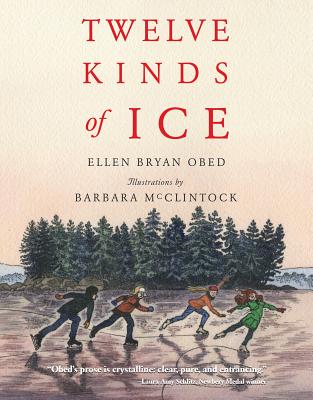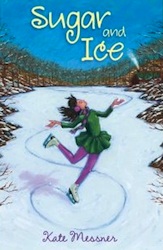It’s probably no surprise that someone who writes books like these…
…is a winter person. I love summer, but winter light and winter quiet feed my soul in a different way. If you’re that kind of person, too, you won’t want to miss this small, lovely book called TWELVE KINDS OF ICE, written by Ellen Bryan Obed and illustrated by Barbara McClintock.

Don’t expect a novel; this is more the kind of story your grandmother told you over hot chocolate — a remembrance of wintry childhood memories that celebrate all that’s good and pure and wildly fun when it comes to being a kid. It starts with the ice on the sheep pails in the narrator’s barn, “an ice so thin that it broke when we touched it.” The language in this personal narrative is as crisp and sparkling as the ice itself. But it was the section on Black Ice that resonated with me the most:
We could see the clouds, the blue sky, the tree-edged shoreline, in the mirror of black ice beneath us. We could see ourselves in the glass, our long-winged spirals, our flashing blades, our new mittens.
This is the kind of ice we live for at my house on Lake Champlain. And as I read yesterday, the temperature was plunging for the third night in a row. This morning, it was -16 when I woke up. When I got home from taking the kids to school, I went out back and down the stairs to the lake. My back yard gets a lot bigger this time of year.
I found what I was hoping for — that smooth, perfect, black ice — and an unexpected gift, too. Delicate, feathery frost flowers…
An article I found in New Scientist says this is mostly an Arctic phenomenon. Here’s an excerpt:
Grae Worster and Robert Style of the University of Cambridge found that frost flowers form mostly in still, dry air. The key factor is air that is much colder – by around 20 °C – than the water below the ice, they say.
Under these extreme circumstances ice vaporises into the dry air and then refreezes in the form of a frost flower. The pair confirmed this by recreating such conditions in the laboratory. They grew frost flowers from fresh water at 0 °C by cooling the surrounding air to around -25 °C.
I love it when science makes magic like this. Here’s an NPR feature about the phenomenon.
It wasn’t long this morning before cold hands and warning noises from the not-quite-thick-enough ice sent me scurrying back to the stairs. I’ll be working in my writing room overlooking the frozen lake today, warmed by hot tea and a space heater…and the memory of magical flowers that bloom on the ice.







Beautiful pictures – thanks for sharing. I’ve learned something new this morning! That’s always a good way to start the day.
Absolutely awesome Kate!
How lucky you are to live so close to all that everchanging beauty; thanks for posting the pictures I’ve never seen anything like that.
Just beautiful !!
Oh! Those are just gorgeous!!
Saw some footage on the news last night where a guy was “showing off” for kids. He poured boiling water into a pitcher, then threw it into the air – and it turned into steam and snow. So cool. (No pun actually intended.)
Oh I’m so envious of you. That view is a lovely way to write!! Thank you so much for sharing the beautiful pics. These books look like special winter readings.
Wow — those are stunning!
Love the pictures and informational links. Can’t wait to learn more about frost flowers.
You almost make me like winter. And yes, “Twelve Kinds of Ice'” is a timeless piece of writing!
The picture of your backyard in winter is extraordinary! Absolutely gorgeous.